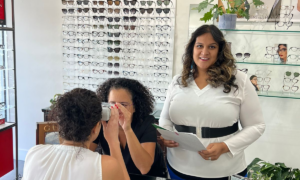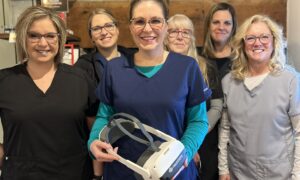
Photo credit: Getty Images
Optimizing contact lens revenue strategies.
By Barbra Dey, BSc Optom, COE
June 26, 2024
In the competitive landscape of eyecare practices, optimizing contact lens revenue is key for sustained growth and enhanced patient satisfaction.
Remember, our contact lens patients also purchase glasses, and happy patients tell their family and friends.
Leveraging innovative business strategies and embracing technological advancements in lens design can significantly boost revenue streams while ensuring seamless patient experiences.
Here are actionable strategies that worked for me that you can also adopt to elevate your contact lens revenue.
#1: Embrace Newer Technology Products for Higher Margins and Patient Benefits
Staying updated with cutting-edge contact lens technologies not only improves patient satisfaction, but also opens avenues for higher profit margins.
As optometrists, we have a responsibility to keep up to date on new lens designs and materials that offer enhanced comfort and vision correction and are more convenient for the patient (daily lenses).
These advancements often come with enticing rebates for patients, making them more inclined to opt for these upgraded options.
In addition, manufacturers are trending toward increasing the cost of their older technology products, which reduces the practice profit margin, unless the practice in turn increases the lens price, which unfortunately, can drive patients to purchase at a lower cost online.
#2: Focus on Key Contact Lens Manufacturers: What Worked for Me
As a previous practice administrator, I recognized the challenge of staying current with the latest technology in the contact lens world, particularly when dealing with an overwhelming number of trials from multiple manufacturers.
Other Articles to Explore
To address this, I collaborated with the OD team to align our product offerings with our mission and values.
First, we removed older technology lenses, and then through in-depth discussions with representatives of the top manufacturers, we assessed their product offerings, programs and incentives to develop a new approach.
Our strategic plan aimed at offering premium soft contact lens products, minimizing costs and maximizing rewards. This led us to align with two vendors that the OD team believed catered to 90+percent of their soft lens prescribing needs.
Simultaneously, we explored virtual bank options for additional cost savings. We curated a portfolio of lenses from our chosen manufacturers, offering daily, monthly and multifocal options.
Our strategic approach addressed the common issue in practices where the overwhelming number of contact lens options makes it challenging for employees to keep track of pricing, rebates, and even the specific modality of contact lens they are working with. The result was an exceptional and consistent patient experience and higher profitability.
More recently, with a client in North Dakota, utilizing these strategies, we reduced the practice’s COGs contact lens ratio from 50.4 percent in 2022 to 46.6 percent in 2023, and increased their CL business net profit by 14 percent year-over-year, or $62,261.
#3: Create a Price Reference Sheet for Staff
With our new curated portfolio, our staff became well-informed advocates, capable of articulating the benefits, value and pricing of the selected lenses.
It’s essential to empower staff with comprehensive knowledge about the value and benefits of the curated contact lens portfolio. Well-trained staff can guide patients effectively, leading to increased sales and improved patient satisfaction.
To help the OD team in the rollout of our new approach, we created a simple price reference sheet comparing the older technology contact lenses with a newer version of the same brand (for two-week lenses we compared them with a monthly and a daily modality).
This helped address any perceptions around increased patient out-of-pocket costs, factoring in significant patient rebates and complimentary shipping to patients’ homes when an annual supply was purchased. We also showed them what the patient’s out-of-pocket differential on an upgrade from a monthly to a daily lens would look like with an annual supply.
In addition to aiding our support staff, these small gestures changed doctor prescribing habits, enough to impact the bottom line.
We considered incentivizing the ODs for prescribing newer technology contact lenses, following the practice mission around offering the best in technology to their patients. The results from patient satisfaction surveys and from a practice profit perspective were astounding.
#4: Simplify Patient Interactions with Direct Shipping
In today’s fast-paced world, we want to make it easy for patients to do business with us. Consider the efficiency of platforms like Amazon.
The practice of shipping a patient’s contact lenses directly to their home serves not only to spare them a visit to the office, but also to alleviate the considerable workload associated with your staff unpacking boxes, notifying patients and managing in-person interactions during pick-ups. It is estimated that this is at minimum a six-minute savings per patient.
The best practice is to offer annual supplies to all full-time contact lens wearers. However, even for those who opt for a lesser quantity, the optimal approach for both the patient and the practice is to have the lenses shipped directly to their doorstep. This added convenience holds the potential to significantly elevate patient satisfaction and foster long-term loyalty.
#5: Implement Online Retail Platform
If you haven’t done so already, consider implementing an online retail platform to cater to patients who prefer purchasing contact lenses independently of their in-person visits. This platform should seamlessly integrate with your practice’s electronic health records system, offering a user-friendly and convenient shopping experience.
With various options available, I recommend conducting thorough research to identify the service that aligns best with your practice’s needs.
Some platforms may entail a monthly fee for their software, but don’t be deterred by this. The potential uptick in traffic and purchases originating from your practice could readily offset the associated fee, making it a worthwhile investment.
#6: Harness EHR Technology for Efficient Ordering
Integration of the EHR system with manufacturers’ or a third-party distributor is a huge value -add. This integration eliminates the need for dual data entry, reducing errors and saving staff time. Some distributors may include additional expenses, but the payroll cost savings often outweigh these costs.
Bottom Line: You Need a Multifaceted Approach
Elevating contact lens revenue demands a multifaceted approach, blending technology, strategic partnerships and patient-centric services.
By embracing newer technologies, forging strong relationships with manufacturers, simplifying patient transactions and leveraging EHR platforms, practices can unlock untapped revenue streams while ensuring optimal patient care and satisfaction.
These strategies not only enhance the bottom line, but also position the practice as a leader in providing comprehensive eyecare solutions.
 Barbra Dey, BSc Optom, COE, is the president of Dey Ophthalmic Consulting. Barbra served as CEO of a major practice from 2010 until August 2021 when she decided to embark on a new journey to take her experience and knowledge to grow private eyecare practices across the U.S., and show them how to thrive in today’s competitive market. To contact her, e-mail: barbradey@outlook.com
Barbra Dey, BSc Optom, COE, is the president of Dey Ophthalmic Consulting. Barbra served as CEO of a major practice from 2010 until August 2021 when she decided to embark on a new journey to take her experience and knowledge to grow private eyecare practices across the U.S., and show them how to thrive in today’s competitive market. To contact her, e-mail: barbradey@outlook.com

























